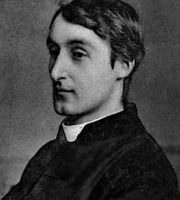About Gerard Manley Hopkins
Gerard Manley Hopkins (born July 28, 1844 in Stratford near London - June 8, 1889 in Dublin) was a British poet and Jesuit whose poetry is admired above all for the vibrancy of its expression. He is considered one of the most daringly experimental and innovative poets of Anglo-Saxon literature: especially his very personal use of alliterations is worth mentioning. He was considered by the critics of the Victorian and Edwardian age as an eccentric and only after the experience of Ezra Pound and Thomas Stearns Eliot was he fully recognized as a great experimenter and innovator of poetic language and metrics.He attended Highgate School. The son of an insurance salesman, He studied at Balliol College, University of Oxford, where he became a supporter of Edward Bouverie Pusey and joined the Oxford Movement. It was also at Oxford that he began his friendship with Robert Bridges, which was to have great significance for his development as a poet. In 1866 he followed Newman's example and converted to the Roman Catholic Church. He studied theology at St Beuno's College, Tremeirchion, North Wales. In 1868 he entered the Jesuit order and gave up writing poetry for seven years. In 1882 he became a teacher at Mount St. Mary's College Sheffield and at Stoneyhurst College Lancashire. He later became - as a priest - Professor of Classics at University College Dublin.
Hopkins did not publish any of his poetry during his life. It was only due to the efforts of his friend Bridges that his collected poetry was published in 1918. Among them were The Wreck of the Deutschland (written in 1876, referring to the sinking of the Deutschland), The Windhover and Pied Beauty. Today he is one of Britain's most admired poets. He died of typhus in Dublin on June 6, 1889.
His historical importance is due in large part to its innovations in poetic form. Before Hopkins, Middle and Modern English poetry was based on a rhythmic structure descended from the Norman side of English literary heritage. This structure was based on repeated groups of two or three syllables, with the stressed syllable in the same place on each repetition. Hopkins called this regular meter running rhythm. Although he wrote some early verses in running rhythm, he was later fascinated by the older rhythmic structure of the Anglo-Saxon tradition, of which Beowulf is the most famous example. Hopkins called this rhythmic structure jump rhythm. This jumping rhythm is based on feet with a variable number of syllables, usually between one and four per foot, with the stress always falling on the first syllable of a foot.
For Hopkins, the jumping rhythm made it possible to escape from the regularity of the running rhythm, which he felt was bound to make poetry written in him "lame and tame. Many contemporary poets followed Hopkins' lead, although most did not adopt the jumping rhythm, abandoning traditional rhythmic structures in favor of free verse altogether.
Hopkins also underpinned his poetry with the concepts of inscape (ingestalt) and instress (inforce), with which he tried to express that everything in God's creation has an individual formative power and can thus captivate every viewer. Nature and religion, God and man became central themes for him. Hopkins' poems still impress today with their original neologisms, often obscure metaphors, deliberate breaks in semantics and syntax and, above all, with the innovative metrics of the jumping rhythm.
Browse all poems and texts published on Gerard Manley Hopkins









